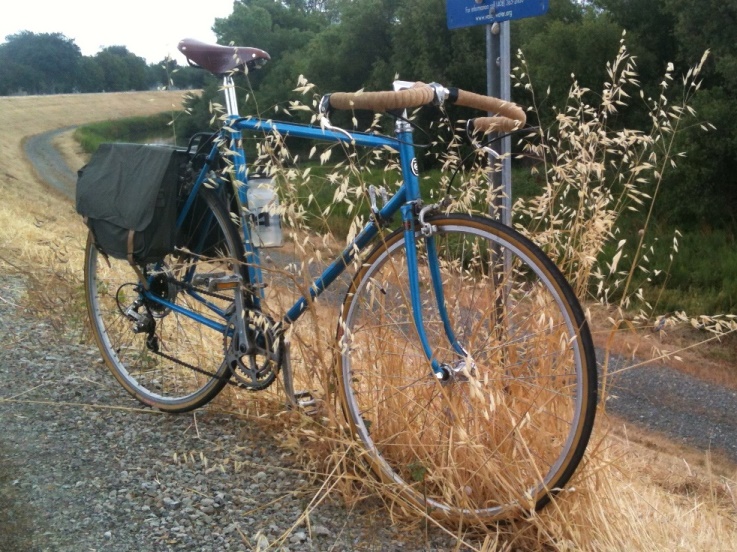“Some Thoughts on Bicycle Races, Machines and the Self (Without Too Much of an Apology to Robert M. Pirsig, Whose Book on Motorcycles, the Machine and the Self, I Didn’t Understand Enough to Like Much)”
Note: sometimes I use my space in Contact as a way of writing about important issues in the life of the church. This is not one of those times. This week I’m just writing for fun.
Here’s a confession: I’m a closet fan of professional bicycle racing. I realize that as confessions go, this one is hardly a bombshell—it is (ahem) racy, but not in such a way that any kind of scandal will arise from it. This is a confession because cycling is not the kind of sport to which American Males ordinarily are expected to pay much attention. For one thing, in cycling the athlete with the strongest legs, the greatest tenacity, the truest grit—and here I’m talking about the racer who is the fastest climber of mountains—is rewarded by getting to wear a polka-dotted spandex shirt. And while the play is aggressive, and sometimes really dangerous, the sport is not violent and the machines involved aren’t nearly as testosterone-infused as are the vehicles used in NASCAR races.
I rather doubt many men retreat to man-caves to watch the Tour de France, but that’s why I like the sport. The very best way to watch a bike race is to take a picnic, find a beautiful spot along the race’s route and share a meal with friends (note the price tag—or lack thereof). Often complete strangers sitting next to each other share the contents of their picnic baskets and become friends, joyfully ringing cowbells together as the racers zip by (rather than doing a wave or giving and receiving high fives, those who watch bicycle racing—for reasons I cannot really explain—ring cowbells). Lead me not into the man-cave with its big screen and its eau de guy. Instead, give me a field of lupines and poppies, a blanket, a lovely baguette, a wedge of soft cheese, a bottle of wine, a blue sky, a cowbell and good companions.
This year is maybe only the second year in the last decade that I have not watched the Tour of California in such a manner, and I’m sorry to miss it. More often than not, the Tour went right by the front of my church in San José (My former church sits on the base of Mount Hamilton, on the way to Sierra Road both of which are among international bicycle racing’s most important North American climbs); maybe next year the tour will come through Oakland. I think Skyline would make a fine route for a race.
Last weekend two of the sport’s biggest events—the Giro d’Italia and the Tour of California got underway, and over the years I’ve noticed that during the roughly two and a half months that span the start of the Giro d’Italia and the end of Tour de France the average value of the bikes I see out on the roads here in California trends up significantly. When the big races are happening fans of the sport tend to go out and purchase racing bikes or they dust off the neglected racing bikes they already own. They dress in outfits that cost more than a Brooks Brother’s suit, and they hit the hills, their equipment functioning as an expression of their love for the sport and perhaps as tangible extensions of their fantasies, in which they are members of the world’s cycling elite, maneuvering in the peleton, preparing to break away from the pack while ascending the Alpe d’Huez.
I have a great deal of respect for those for whom equipment is a means of self-expression. I ride a bike that I put together as an exercise in self-disclosure (see photo below), and I’d never trust a carpenter, mechanic or plumber whose tools weren’t an extension of his or her self-identity. But sometimes, when the association of person and equipment becomes too close, an inversion can occur such that we become extensions of our machines. We organize our lives around what’s on TV, we go into debt so that we can have an up-to-date computer, our smart phones capture our gaze and hold our attention, even when surrounded by beauty and in the presence of loved-ones. When our equipment defines us (rather than the other way around), then our stuff becomes a source of impatience—our car will never be quite nice enough, our bike will not be new enough, and our electronics never will be quite in vogue, and we long for everything that is new so that we will be defined by that newness.
Here is another reason to love bicycle races: it is a sport for patient fans. To watch a race live is only to see—at best—a quarter of a mile in a day of riding that could cover as much as 150 miles. It might be the most boring quarter of a mile, or it might be the most exciting—one never knows—and the amount of time one actually spends looking at professional athletes on bikes can be rather short, so the fan of cycling ends up cheering for the wine and the cheese and the bread. The poppies and the lupine are the true champions and the enjoyment of time with friends cause a fan to ring a cowbell with reckless abandon. An attentive and patient fan of cycling will see that the greatest gifts of the sport have little to do with expensive accouterment; rather, by inviting its fans to us to spend hours in happy, lazy anticipation, waiting for the peleton, the sport of professional cycling’s greatest gift may not be in the speed required to compete but in the slowness necessary for those who would be spectators.
Ben

